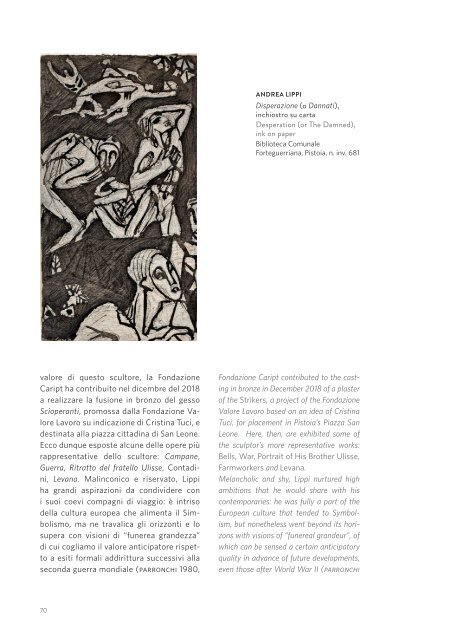Pistoia Novecento 1900 - 1945
a cura di / curated by Annamaria Iacuzzi Philip Rylands
a cura di / curated by
Annamaria Iacuzzi
Philip Rylands
Create successful ePaper yourself
Turn your PDF publications into a flip-book with our unique Google optimized e-Paper software.
valore di questo scultore, la Fondazione<br />
Caript ha contribuito nel dicembre del 2018<br />
a realizzare la fusione in bronzo del gesso<br />
Scioperanti, promossa dalla Fondazione Valore<br />
Lavoro su indicazione di Cristina Tuci, e<br />
destinata alla piazza cittadina di San Leone.<br />
Ecco dunque esposte alcune delle opere più<br />
rappresentative dello scultore: Campane,<br />
Guerra, Ritratto del fratello Ulisse, Contadini,<br />
Levana. Malinconico e riservato, Lippi<br />
ha grandi aspirazioni da condividere con<br />
i suoi coevi compagni di viaggio: è intriso<br />
della cultura europea che alimenta il Simbolismo,<br />
ma ne travalica gli orizzonti e lo<br />
supera con visioni di “funerea grandezza”<br />
di cui cogliamo il valore anticipatore rispetto<br />
a esiti formali addirittura successivi alla<br />
seconda guerra mondiale (parronchi 1980,<br />
ANDREA LIPPI<br />
Disperazione (o Dannati),<br />
inchiostro su carta<br />
Desperation (or The Damned),<br />
ink on paper<br />
Biblioteca Comunale<br />
Forteguerriana, <strong>Pistoia</strong>, n. inv. 681<br />
Fondazione Caript contributed to the casting<br />
in bronze in December 2018 of a plaster<br />
of the Strikers, a project of the Fondazione<br />
Valore Lavoro based on an idea of Cristina<br />
Tuci, for placement in <strong>Pistoia</strong>’s Piazza San<br />
Leone. Here, then, are exhibited some of<br />
the sculptor’s more representative works:<br />
Bells, War, Portrait of His Brother Ulisse,<br />
Farmworkers and Levana.<br />
Melancholic and shy, Lippi nurtured high<br />
ambitions that he would share with his<br />
contemporaries: he was fully a part of the<br />
European culture that tended to Symbolism,<br />
but nonetheless went beyond its horizons<br />
with visions of “funereal grandeur”, of<br />
which can be sensed a certain anticipatory<br />
quality in advance of future developments,<br />
even those after World War II (parronchi<br />
pp. 142-143; cfr. morozzi 2007, p. 19). È<br />
certamente corretto riferire all’ambito della<br />
fonderia paterna la prima vera scuola di Andrea:<br />
precoce nell’apprendere, ebbe modo<br />
di passarvi al vaglio non solo il repertorio<br />
della tradizione scultorea rinascimentale<br />
‘da catalogo’, ma anche, grazie alle più disparate<br />
collaborazioni della fonderia, i coevi<br />
linguaggi plastici italiani ed europei: basti<br />
pensare, al riguardo, alle collaborazioni<br />
dell’azienda con David Calandra o Leonardo<br />
Bistolfi. Tra i grandi scultori del passato,<br />
soprattutto tardomanieristi, il raffronto costante<br />
è con Michelangelo. Tra <strong>Pistoia</strong>, Lucca<br />
e Firenze, Andrea intratteneva a diverso<br />
titolo rapporti con i contemporanei Giovanni<br />
e Romeo Costetti, Achille Lega, Giulio Innocenti,<br />
Giovanni Michelucci, Alberto Caligiani,<br />
Emilio Notte, Mario Nannini, Renato<br />
Fondi, Raffaello Melani, Alberto Simonatti,<br />
Giosuè Borsi ed altri ancora come Luigi<br />
Luparini, Alfeo Faggi, Francesco Petroni e<br />
Lorenzo Viani, autore di un incisivo ricordo<br />
letterario dello scultore pistoiese (viani<br />
1925; morozzi 2007, pp. 18-19).<br />
L’altro polo del dialogo, continuo e interiore,<br />
è con i testi letterari: nella suggestione<br />
riportata dalla lettura trova linfa vitale la<br />
genesi dell’opera. Andrea stesso è scrittore<br />
di mirabili e oniriche visioni che spesso<br />
accompagnano l’elaborazione formale<br />
della scultura. Dante è in prima linea, ma<br />
legge anche William Shakespeare, Edgar<br />
Allan Poe, Charles Baudelaire, e i suoi poeti<br />
prediletti: Giovanni Pascoli e Maurice<br />
Maeterlinck ,“fratelli spirituali” (simonatti<br />
1916, p. 10). Contemporamente legge testi<br />
di alchimia, teosofia e astronomia. È un animo<br />
complesso quello di Andrea, così come<br />
complessa deve essere l’opera d’arte. Pensa<br />
a un’opera capace di comprendere tutto e<br />
di divenire simbolo: “Io volevo riunire quello<br />
che è separato nella materia ma unico in<br />
1980, pp. 142-143, see morozzi 2007, p.<br />
19). Lippi’s first real school was undoubtedly<br />
his father’s foundry. A quick learner,<br />
he not only traversed the ‘catalogue’ of<br />
the Italian Renaissance sculptural tradition<br />
but also, thanks to the foundry’s many and<br />
various commissions, the Italian and European<br />
plastic languages of his own time (the<br />
foundry’s collaborations with David Calandra<br />
and Leonardo Bistolfi are examples).<br />
Among the great sculptors of the past,<br />
especially the late Mannerists, Michelangelo<br />
was the constant point of reference.<br />
Between <strong>Pistoia</strong>, Lucca, and Florence, Lippi<br />
was in touch one way or another with many<br />
of his contemporaries: Giovanni and Romeo<br />
Costetti, Achille Lega, Giulio Innocenti,<br />
Giovanni Michelucci, Alberto Caligiani,<br />
Emilio Notte, Mario Nannini, Renato Fondi,<br />
Raffaello Melani, Alberto Simonatti and<br />
Giosuè Borsi, and still others, such as Luigi<br />
Luparini, Alfeo Faggi, Francesco Petroni and<br />
Lorenzo Viani, author in 1925 of a perceptive<br />
memoir of the Pistoiese sculptor (viani<br />
1925; morozzi 2007, pp. 18-19).<br />
The other focal point of Lippi’s continuous,<br />
inner dialogue was literature. The genesis<br />
of his work found its lifeblood in notions derived<br />
from reading. He was himself a writer,<br />
of exquisite, dreamlike visions that often<br />
accompanied the formal elaboration of his<br />
sculpture. Above all there was Dante, but<br />
he also read William Shakespeare, Edgar<br />
Allan Poe, Charles Baudelaire, and, his favourite<br />
poets, Giovanni Pascoli and Maurice<br />
Maeterlinck, “spiritual brothers” (simonatti<br />
1916, p. 10). At the same time, he delved<br />
into texts on alchemy, theosophy, and astronomy.<br />
Lippi was a complex spirit, just as<br />
a work of art must be complex. He had in<br />
his mind a work encompassing everything,<br />
captured in a symbol: “I wanted to bring together<br />
what is separate in matter but one<br />
70 71













